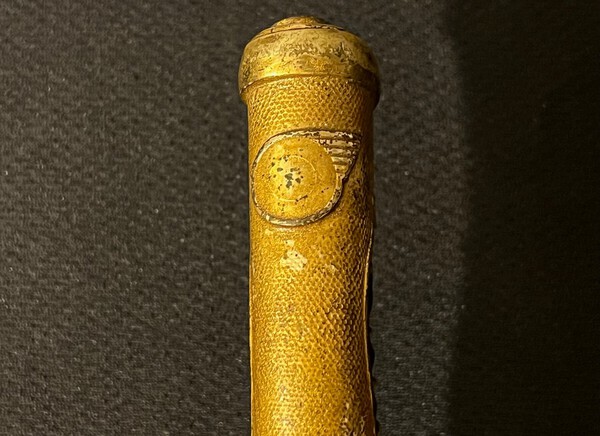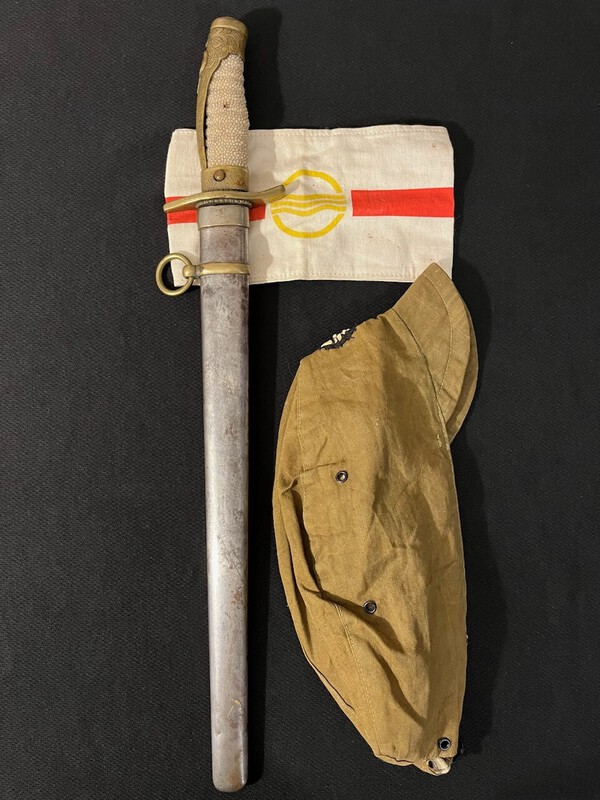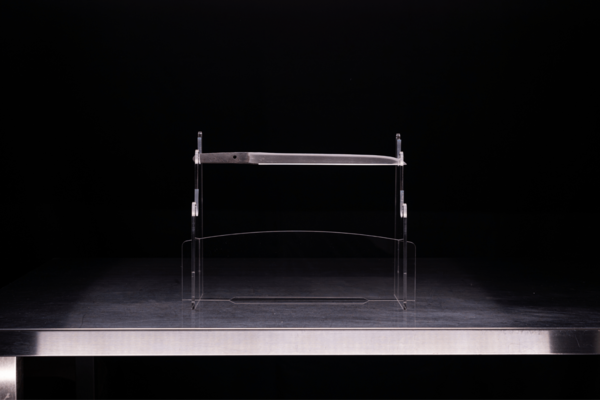Search the Community
Showing results for tags 'tanto'.
-
Hey Guys, I’ve recently found this Tanto and a few people on Reddit said it’s probably real, but I still don’t have informations about it and I thought maybe someone on this forum could help a little bit. I’ve taken a few more better photos and added informations for the Tsuba and blade below. (Also more Pictures) Unfortunately the blade is in pretty rough shape, but I like the fittings. I’ve found some kind of signature on the Seppas and on the Habaki, which I’m pretty sure is gold plated, but the Tang is unsigned. I hope I didn’t miss a lot but I could add photos or information anytime. Maybe someone on here can identify a bit more about the Tanto Tsuba: Weight: 68.5 grams Thickness: 4mm Length: 6cm Width: 4.7cm Rim: Maru Mimi Shape: Mokko Gata Blade: Nakago length: 10.2cm Nagasa length: 28.3cm https://ibb.co/hvMJKBM https://ibb.co/gZQWm7hs https://ibb.co/x8g35Wjk https://ibb.co/KcSwG2ch https://ibb.co/97swXTK https://ibb.co/LzsBcXNq https://ibb.co/yF2DGMJq https://ibb.co/5WqxT3M3 https://ibb.co/PZR3cpy0 https://ibb.co/FbTSNyZn https://ibb.co/BVdf33VK https://ibb.co/VyCy3R6 https://ibb.co/kVYFvt0r https://ibb.co/0yr4rZXw https://ibb.co/ynmMW2Bd https://ibb.co/TDmCJb86 https://ibb.co/pjQdsV2r https://ibb.co/FkZ4fVZd https://ibb.co/7x6b17fS
-
Hello everyone, I recently acquired an old tanto blade from a flea market in Japan, and I would be very grateful if the experts here could help me better understand its origin and purpose. Here are some measurements and details: Nagasa (blade length): 23 cm Nakago (tang length): 8.5 cm Mekugi-ana: two holes, the first located about 3.5 cm from the machi, and the second about 1 cm apart from the first. The tang shows natural dark brown patina, not artificial rust. The blade edge is not sharp, and the kissaki (tip) appears to have been either intentionally ground flat or perhaps never sharpened. The overall geometry still follows the traditional tanto shape with a visible shinogi ridge. According to the seller, the blade had been stored wrapped in newspaper for a very long time, and some paper fibers seem to have fused into the rust on the surface. I would really appreciate your opinions on a few questions: Does this appear to be a genuine old nihonto blade , or could it be an unfinished ? How should I safely clean or stabilize the surface, especially the rust mixed with old paper residue, without damaging the patina on the nakago? Thank you very much for your time, patience, and for sharing your knowledge with newcomers like me. I really appreciate any guidance and feedback you can offer. Any comments or suggestions will be greatly appreciated. Best regards,
-
Type :Tanto Ubu : Mei :: Morishige Era/Age : Showa (1985) Shirasaya, Koshirae or Bare Blade? : Shirasaya Hamon Type : Suguha Flaws : Light kizu Sword Location : USA Will ship to : USA, International at buyers risk Payment Methods Accepted : PayPal, Zelle Price and Currency : $850 USD Other Info and Full Description : Offering a very interesting special order shinsakuto Tanto for sale. This Tanto was created by smith Morishige in August, 1985 responding to a request made by a Mr. Yanagi Gado. The blade features a Suguha hamon with a very misty nioi-guchi. Looking at the folds in the blade is almost like looking at waves rippling in the ocean. The habaki is solid silver as well, weighing a hefty 20.6 grams. The Mei is intricately carved and covers almost all of the Nakago in writing. I’ve attached a translation below. Please see the imgur album for more pictures https://imgur.com/a/LGxmuoV 東海道清水住人、盛重作 – A resident of Tokaido Shimizu, Morishige made. 応好 柳雅堂氏 – Responding to the order from Mr. Yanagi Gado 家運長久 – Good future for the family 昭和六十乙丑年八月日 – Showa 60 Kinoto-Ushi year (1985), 8th month Blade is in polish and overall excellent condition other than light kizu as depicted. Small ding on the shirasaya (also depicted). Asking $850 shipped
-
Hello, need help with this Mei I think it's Showa 3. I've had it in my collection for some years and need some help determining what the Mei is. Thanks
-
So, after buying a few books to learn about Naginata and Naginata-naoshi, the Knutsen book on Japanese polearms mentions that at one point, repurposing yari (especially hira-zukuri) into tanto was fairly common. Now, I've seen plenty of Naginata-naoshi and Naginata-naoshi-zukuri, but don't recall ever seeing a Tanto being described in a similar way (former yari with shortened nakago etc). Does such a thing exist, or are they just described as suriage etc. (with or without mention of previously being a yari)?
-
Hi everyone. I found this in my grandfather’s attic earlier in the year. He served in the US Navy during WWII. He was in the Pacific Theater, taking part in the campaigns of Guadalcanal and the Solomon Islands. I know it’s Japanese, but not much else. The blade has obviously been machined and cut from a longer blade, but I don’t know what the original could have been? The steel seems lightly pitted and corroded but relatively smooth. I see a niji-mei, “小鍛” kokaji? If anyone has any idea about this blade I’d greatly appreciate your input! I’m assuming it has little value and might try polishing or restoring it myself. Dom
-
Hello everyone, I recently acquired this tanto and I would like to ask for your opinions about it. Here are some details and photos: Nagasa (blade length): approx. 16 cm (measured from munemachi to kissaki) Overall length: approx. 30 cm Width at base (motohaba): about 2 cm Thickness (kasane): about 0.5 cm Nakago: 1 mekugi-ana, patina is visible, some marks but no clear mei (or faint inscription) Hamon: visible but not very clear due to condition, seems irregular in places Kissaki: rounded, with visible yokote Sugata: resembles a hira-zukuri tanto Condition: some rust and scratches present, needs polish to show hada/hamon more clearly I am mainly hoping to learn whether this is an antique nihonto or a more recent blade, and if possible, which period or school it might belong to. Any comments or advice would be greatly appreciated. Thank you very much in advance for your help! JackDo
-
-
New swords just added. Click on the link to take a look: https://stcroixblades.com/product-category/Japanese-swords/ If you have any questions, need more photos, etc., just let me know. --Matthew Brice St. Croix Blades
-
An ō-tanto or ko-wakizashi with NBTHK Hozon to Fuyuhiro. Measurements: Nagasa: 31 cm (12.2 inch) Motogasane: 6 mm (0.236 inch) Motohabaa: 2.7 cm (1.06 inch) Blade characteristics: Deki: Nioi deki, Hamon: ko-midare Activities: chikei, shirake utsuri, koshiba Hada: itame. About koshiba: Koshiba is a feature of the hamon that you can find only in ubu blades. It is a milder part of the hamon at the beginning of the it,and it lacks a clear nioi-guchi. It can be found only be found only on 12th-13th century blades (if a natural result of yaki-ire) or on blades from the 15th century if it's designed. I have not found any evidence that it was a feature of Fuyuhiro. You can read about koshiba here: http://www.ksky.ne.jp/~sumie99/yakiotoshi.html#koshiba Drawing of koshiba by Kojima Hiroshi (Kei'un Naohiro) Important remarks: 1. Boshi is not very distinct (see pics on Dropbox) 2. There is a delamination close to the mune. You can see it in my photos on Dropbox. 3. Chikei are clearly visible in the koshiba, and they are very beautiful. Chikei consist of streaks of nie and must not be confused with hada. 4. The sword comes in a shirasaya and with copper habaki. 5. The polish is sashikomi. 6. This sword is not a piece of art, but a real weapon. However, it is full of interesting activities, that are difficult to see in my pics. 7. Personally I think this might be a much older sword than Fuyuhiro. The school did not produce koshiba. Bu, to all intent and purpose, the NBTHK has "made" this sword a Fuyuhiro. The magic of papers... About Fuyuhiro: Fyuhuhiro were a lineage of smiths in the Wakasa province. The first Fuyuhiro is said to have been a pupil of Sōshū Hirotsugu. He florished in the Kōshō era (1455-1457). Earlier generations worked in hoso-suguha, sugu gunome midare and notare gunome. Later generations worked often in hitatsura. More pictures: This sword is hellishlu dificult to photograph, I heva tried my best, but the results are so-so... https://www.dropbox.com/scl/fo/xa3bm1jp1p12emsoc9ufp/AJdYi07qqcL6v23a3QRDqfI?rlkey=zywer9px6a1mb97hr5lcy87b0&dl=0 Price: EUR 1,050 incl. shipping to EU or US, others please ask Payment: Wire transer in EUR to a European bank account or in US$ to a US bank account (domestic transfer) Paypal possible, friends and family, otherwise buyer pays the PayPal fees on top of the price Shipping: Priority mail, registered, with tracking. Any courier service at extra charge (if they ship swords at all)
-
Hello all. I bought this tanto a few months ago. I did not note down what the seller provided as the mei translation. I recall it was translated to "Miyamoto Kanenori". I was doing some research on this smith some time ago after I bought this, I read through a number of threads on here. Kanenori had a very interesting life as a smith, and is considered to be one of the best. This is why I believe this tanto is likely gimei if signed as that particular smith. I apologize for the photos, I found it difficult to take photos of this blade. I would appreciate your thoughts on Miyamoto Kanenori and this blade.
- 3 replies
-
- tanto
- translation
-
(and 1 more)
Tagged with:
-
Dear fellow enthusiasts, My partner and I recently came into possession of a Japanese blade that we believe may be a wakizashi or long tanto, and we would greatly appreciate any insight you might be able to provide regarding its origin, school, or smith. Measurements: Overall length: ~16 inches Blade length: 9 inches (10 inches from habaki to kissaki) Tang length: approx. 8.25 inches Signature (mei) is present on the tang Traditional style mounts with ray skin tsuka and decorative menuki I've attached photos of the tang, mei, and fittings for reference (including closeups of the carvings and tsuka) via Google Drive link. We’re based in Columbus, Ohio and looking to connect with a reputable appraiser or society that can help us better understand the piece and possibly get an appraisal. If anyone has recommendations for JSSUS members, shinsa events, or reliable dealers/experts in the Midwest, we’d be grateful. Thank you all for your time and any assistance you can offer. Warm regards, Em Harris https://drive.google.com/drive/folders/1fcdegMINz8q3n6cwqNWAfaOR8AMWZETq?usp=sharing
-
I recently purchased this tsuba on ebay, can anyone tell me anything about it? I'm new to this whole sword and fitting thing so any help is appreciated.
-
Hello. I need your help to translate the following signatures into a tan to that I believe is Gassan and into a wakisashi that I cannot understand. Thank you very much for your time. Regards
-
Hi everyone, while browsing for swords, as one does, I stumbled across this piece that has in its description celebratory tanto from Muromachi period called "iwaizashi" I would like to ask studied people from this forum that would be able to explain if there is any truth to the statement ? The description states that presented tanto was made as a gift for celebratory occasions and is engraved with chiyotsuru inscription. I will add the full description with pictures below This tanto is a celebratory dagger made in the Muromachi period and called "iwaizashi," and is a rare piece that is rarely found on the market. It was made as a gift for celebratory occasions and was very auspicious, and this piece is engraved with a chiyotsuru inscription. Chiyotsuru is a school of swordsmiths that flourished from the Nanbokucho period to the Muromachi period (1336-1573), also known as the Echizen Rai school, because it was founded by Chiyotsuru Kuniyasu, a member of the Rai Kuniyasu school, who migrated to the Echizen region. Since the crane (tsuru) has been a symbol of good fortune in Japan since ancient times, it is believed that they asked Chiyotsuru, which means crane that lives a thousand years, to create a celebratory dagger. As in any other collecting field buy the thing not the story, and I really like tha blade itself but if the story proves somewhat true it would be a strong contender for my next purchase. So I share it with all of you good people here, the people more studied than my self. Have a great day everyone.
- 7 replies
-
- 1
-

-
- koto
- translation
-
(and 1 more)
Tagged with:
-
Need some help translating the signature in this tanto, it may be an Edo period piece, but the koshirae may be a more recent fitting. Any clue is appreciated, god bless!
-
I have this small Shin-Shinto tanto I was planning to have a koshirae assembled for it. Here are some photos of the tanto in shirasaya and the handle (tsuka). I picked up this handle today as a birthday gift. I took these photos with my iPhone. I am looking for a tanto sized tsuba that will keep with or be appropriate for the theme of the handle. The menuki are of a tiger in bamboo. I think it would take me some time to find a good matching tanto tsuba. I am not in a big hurry anyways as I just purchased the tsuka.. Feel free to ask questions and discuss politely.
- 13 replies
-
- 5
-

-

-
- tanto
- shin-shinto
-
(and 1 more)
Tagged with:
-
Hi all. New to the forum and to collecting Japanese Swords. A few months ago I bought a Wakishabi which is in a reasonable state of polish but could do with some attention. This weekend I added to my collection a Tanto which was terribly rusty and had been badly scratched with what I assume to have been sandpaper but the guy just wanted to be rid of it as he seemed afraid of it for some reason. I thought the Tanto would be an opportunity to try to learn polishing. I wondered if anyone could read the Mei on either of them.
- 11 replies
-
So, this caught my eye on eBay, I bid and won it for around £200. Obviously, the photos don't reveal too much - as long as it's Japanese I'd be happy with what I paid. The blade was supposed to be late Momoyama / early Edo, but no other details (not sure what will be visible out of polish). Tsuba looks off to me - but 🤷 what do I know. I liked the fuchi kashira and kozuka. Just really intended as a study / conversation piece.
-
St. Croix Blades currently has 50 Japanese swords, tosogu, etc. in its eBay Store listed. You don't have to have an eBay account to purchase. I will pull any item that you wish to buy. Prices are often negotiable. Trades can even be an option (I'll be converting your trade items into cash by reselling them, so the value of your trade items needs to be higher than the negotiated purchase price--I need to take time to photograph and list any trade items, wait for their sale, then ship, etc.). Contact me here to let me know what you would like to negotiate on. https://www.ebay.com...&LH_SpecificSeller=1 Thank you! --Matthew Brice St. Croix Blades
-
I have listed for sale 5 rare Military Dirks in St. Croix Blades' eBay Store...you don't have to be an eBay member, or even like the eBay format (if there are those of you that don't). If you have interest, just reach out to me here. I can negotiate and pull any dirk you have interest in. I think most will agree that I am not overstating the difficulty in locating examples like these when I describe them as rare. Also, let me know if you have any questions. Thank you! https://www.ebay.com...des&_oac=1&_nkw=dirk --Matthew Brice St. Croix Blades
-
Selling a Uda Kunitsugu Tanto with a beautiful Hamon. (blade tip slightly damaged). If you want more pictures please send me a message, I can't add a lot due to file size limit. (We take professional pictures in our studio on Tokyo) Signature: Obverse (Omote): Uda Kunitsugu, Reverse (Ura): - Type: Tanto Blade Length: 25.6 cm Period : Muromachi (around 1429) Measurements: Base width (Moto-haba): Approx. 2.2 cm Base thickness (Moto-kasane): Approx. 0.65 cm Tip width (Saki-haba): Approx. 1.8 cm Tip thickness (Saki-kasane): Approx. 0.5 cm Weight: Approx. 172.7 g (excluding Habaki and handle) Habaki Weight: Approx. 11.8 g Saya (Scabbard) Length: Approx. 41.5 cm Mekugi-ana (peg hole): 1 price : $1130 + $50 Shipping (from Japan)
-
Hi all, A question about this tanto I picked up a few years ago that is unsigned. What novice study I undertook on the blade it appears to be a Soshu-den creation, but would like input if it's actually Shinto blade made in an older style. Thanks in advance.
-
I received a tanto with this white paper, but I need help with the translation, please. Kindest regards






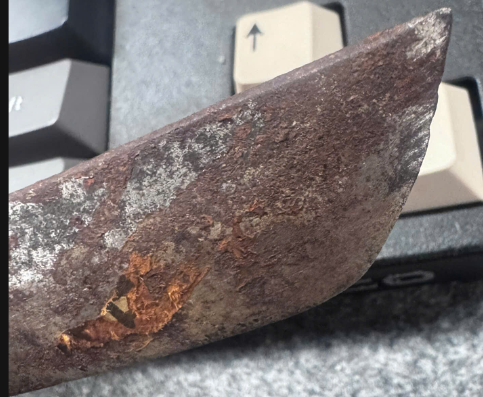



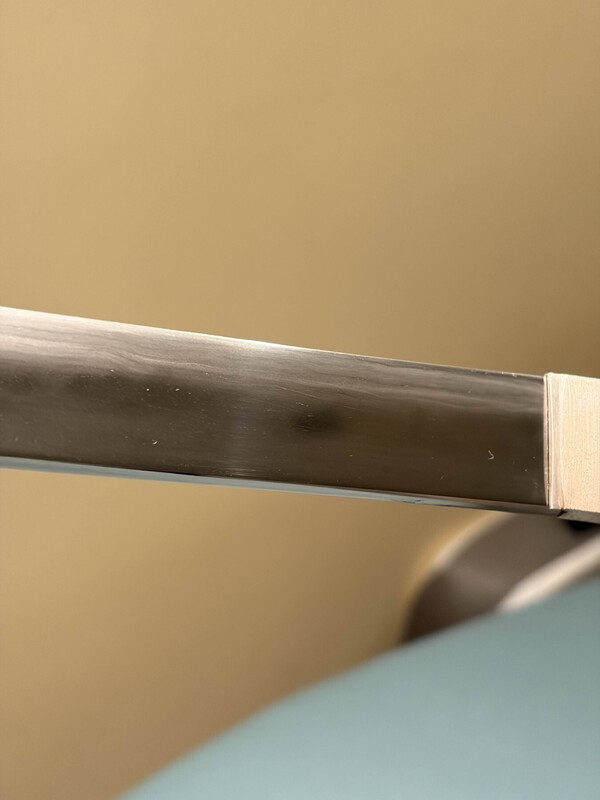
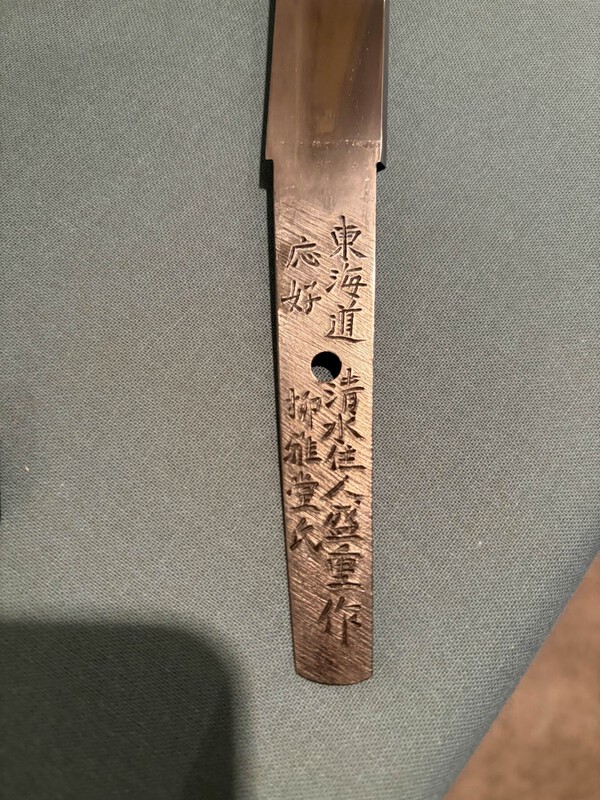


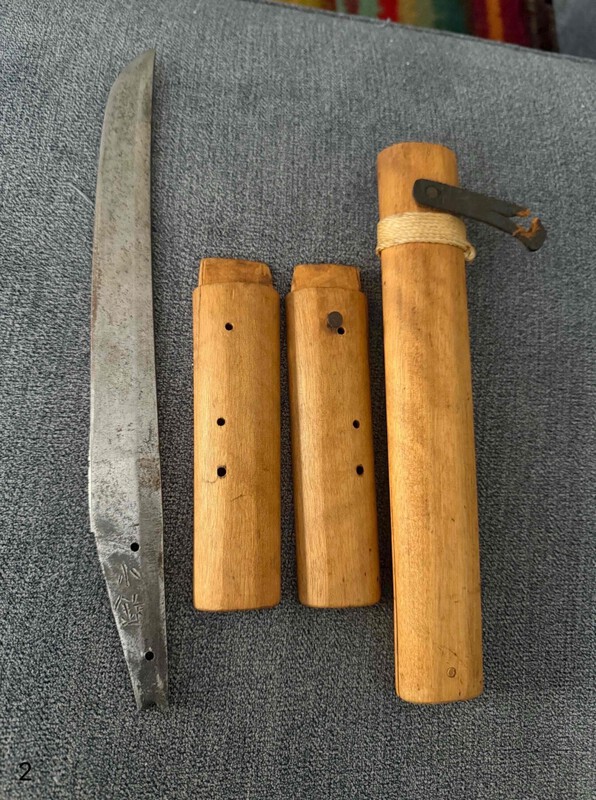









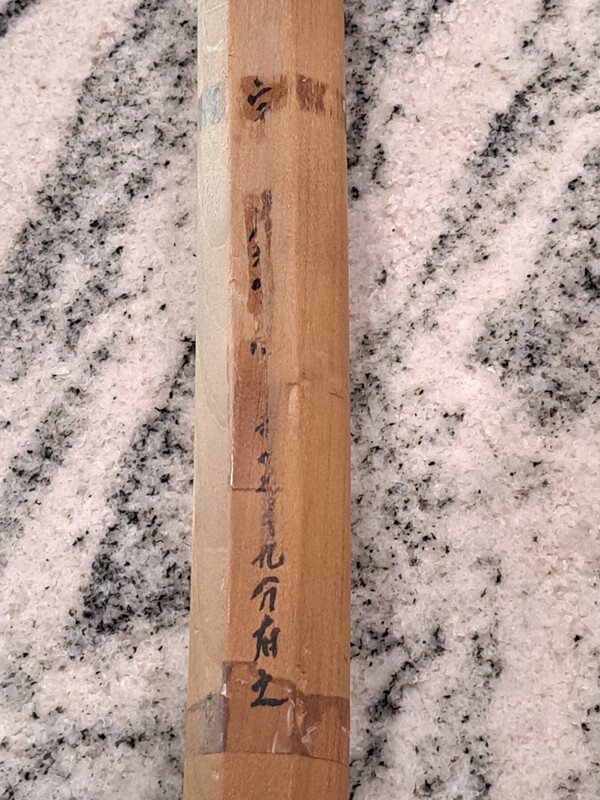



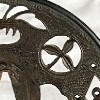



.thumb.jpeg.4714d3666faeb2a0f54ad2a3e24cc23f.jpeg)
.thumb.jpeg.b9c8f211ac045f9640f7376808c02a49.jpeg)
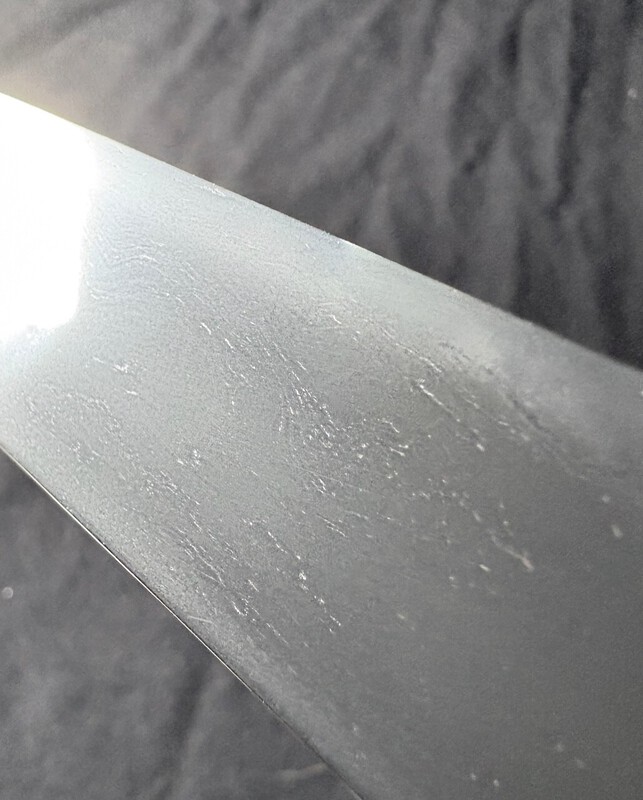
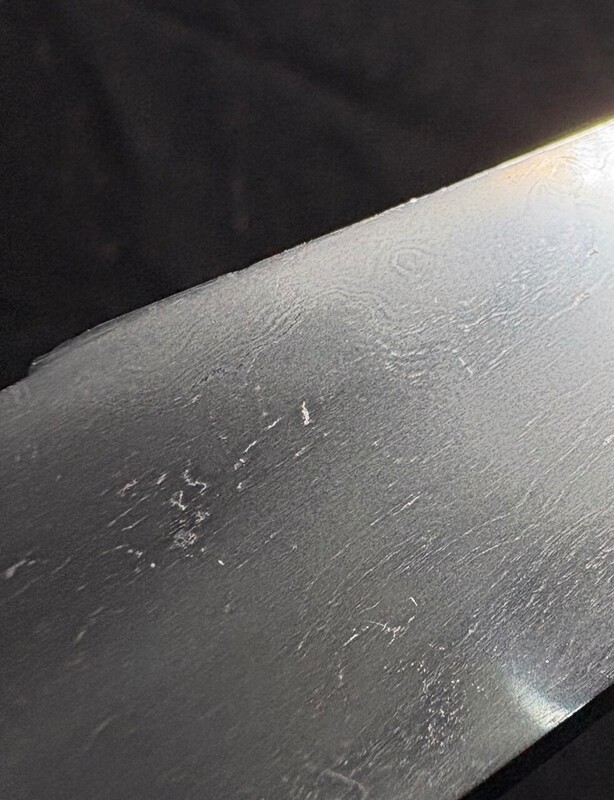
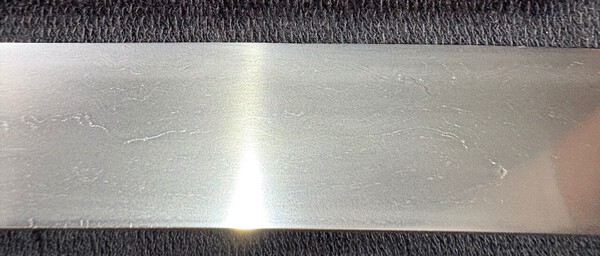
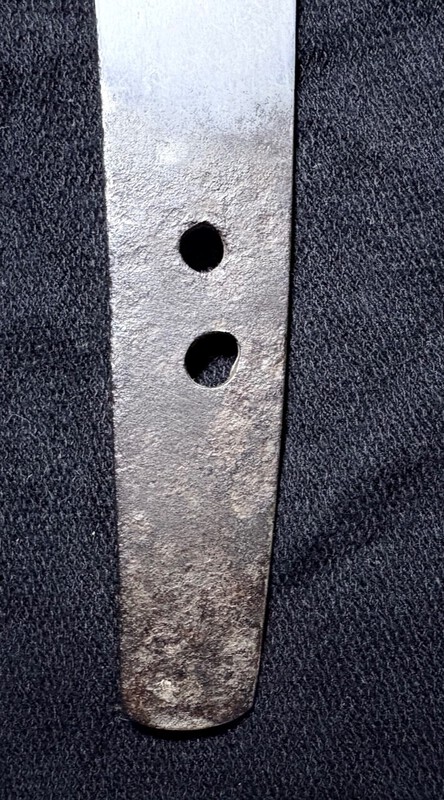
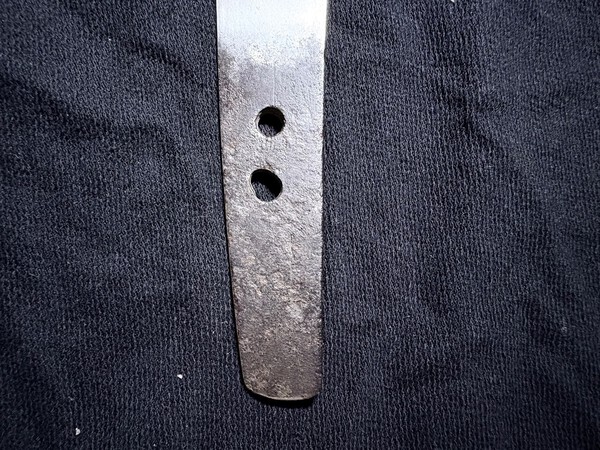




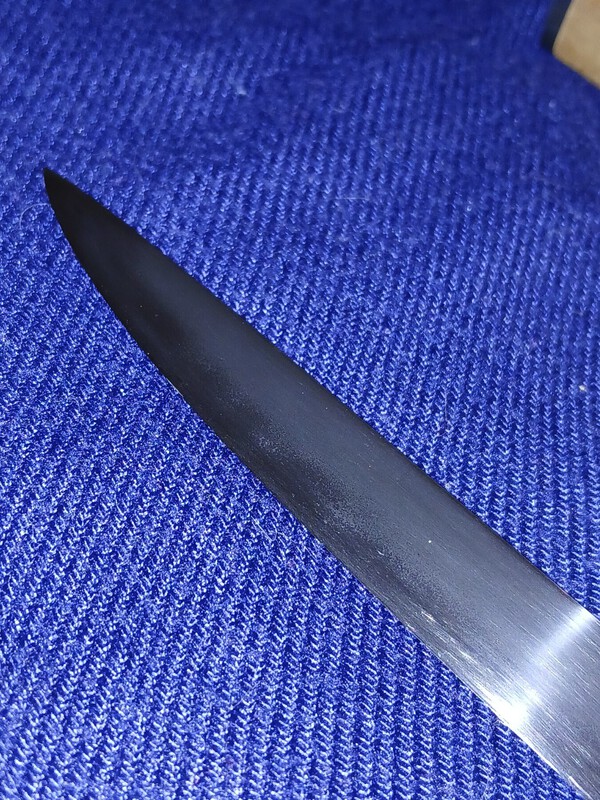























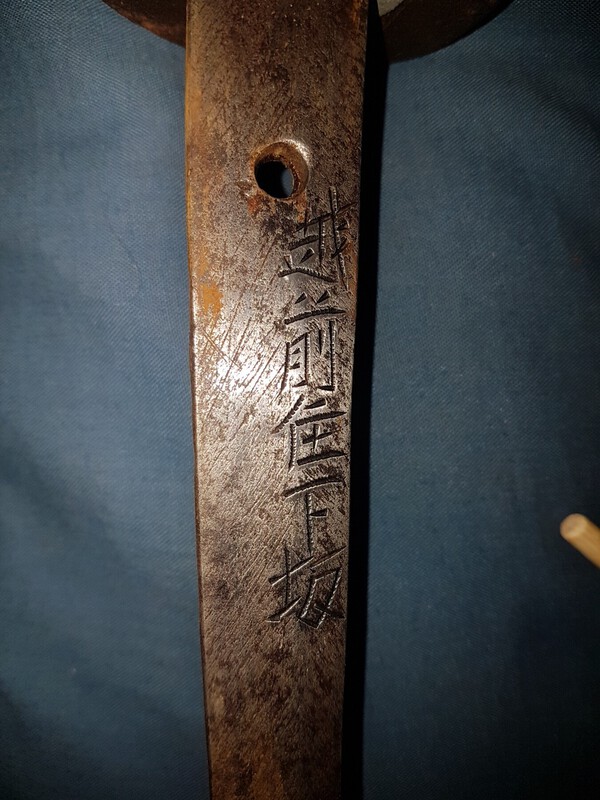



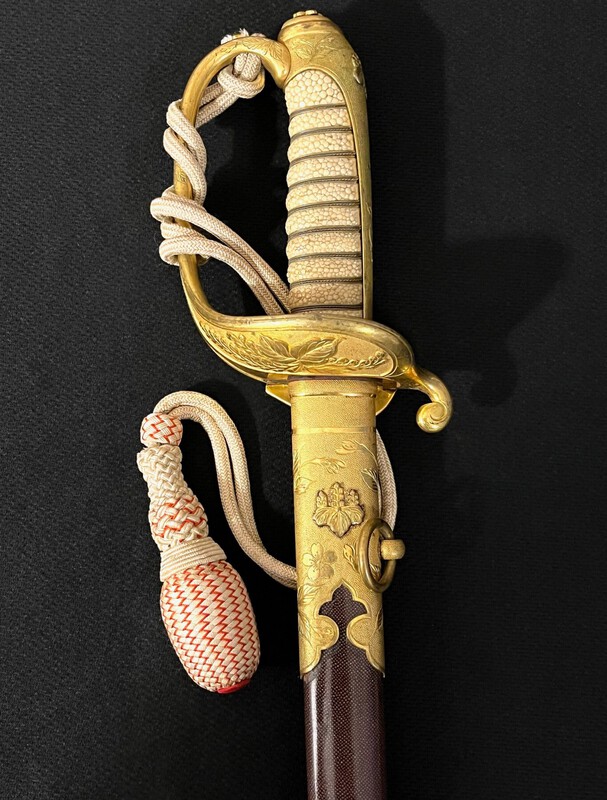



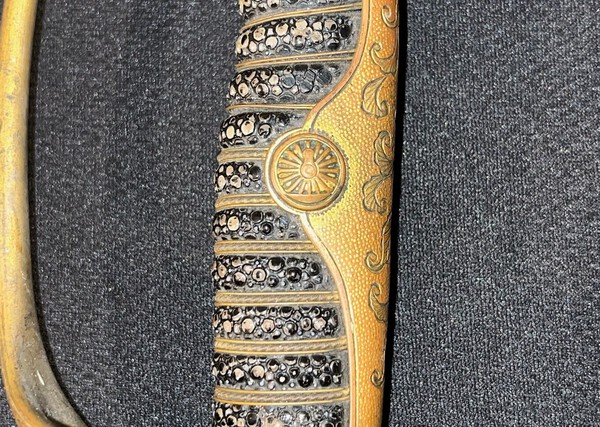
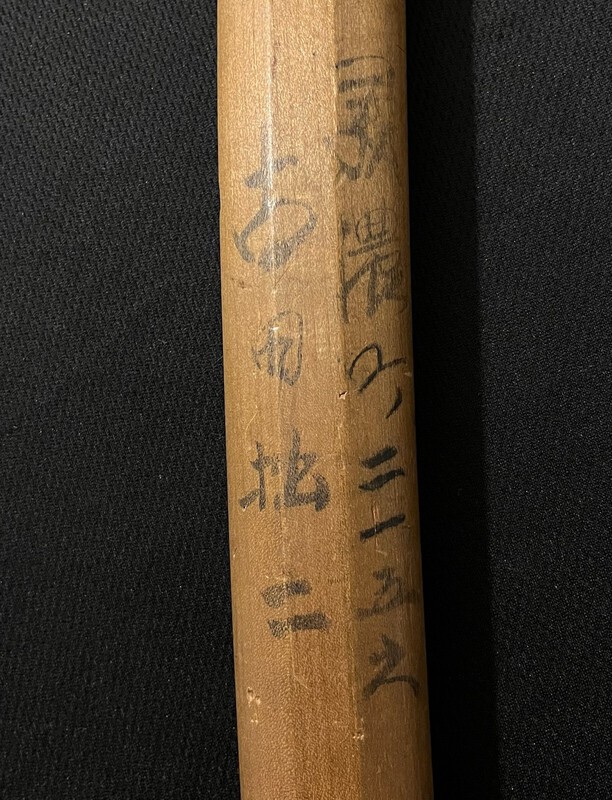
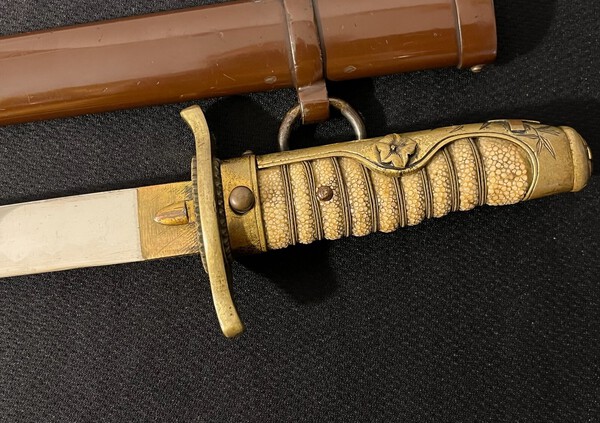
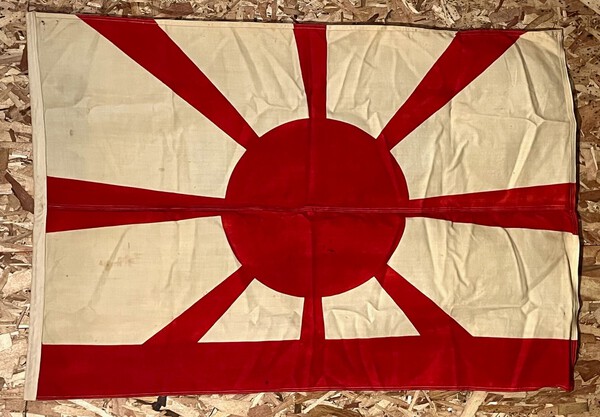
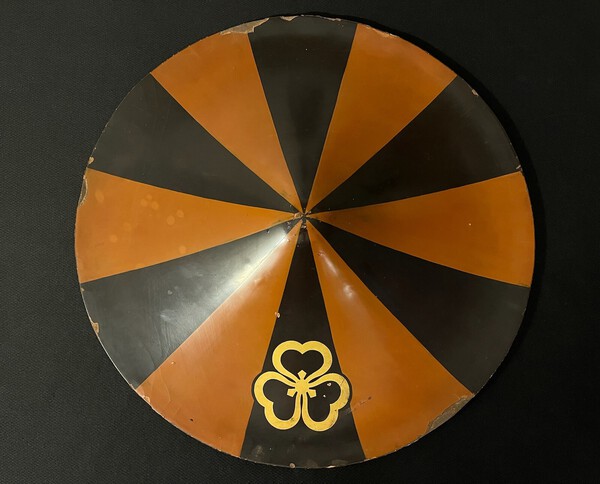

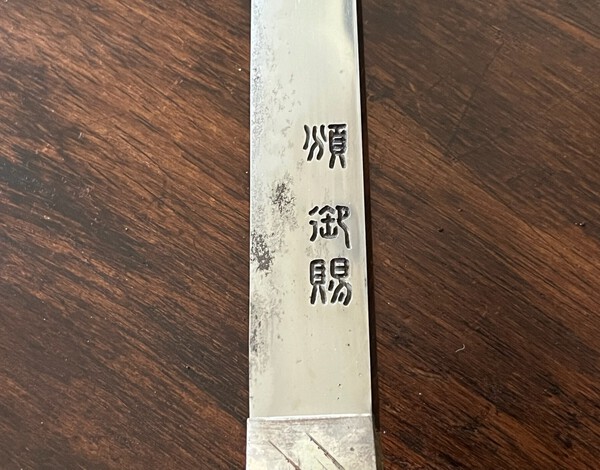

.thumb.jpg.75979474e0853ed03e3ca88322aaa5a8.jpg)
